Blockchain DRM: How Blockchain Protects Digital Content
When you buy a song, a movie, or an ebook, you rarely own it—you just get a license to use it. That’s where blockchain DRM, a system that uses blockchain to control access and usage of digital content without relying on central authorities. Also known as decentralized digital rights management, it lets creators lock down who can copy, share, or resell their work—without needing a middleman like a record label or streaming platform. Traditional DRM, like the kind used by Apple or Adobe, locks content behind passwords and servers you can’t control. If the company shuts down, your access vanishes. Blockchain DRM changes that by storing usage rules directly on the blockchain, making them permanent, transparent, and tamper-proof.
It’s not just about stopping piracy. Blockchain DRM enables new ways to monetize content. Imagine buying an NFT that includes a license to use a digital artwork in your YouTube video—no extra fees, no legal headaches. The license is coded into the token itself. Projects like NFT licensing, a method where digital assets come with built-in usage rights encoded on-chain are already testing this in art, music, and gaming. Even more, decentralized copyright, a system where proof of ownership and creation is permanently recorded on public ledgers gives artists a way to prove they made something first, without paying lawyers or filing paperwork. This isn’t theory—it’s happening in small but growing ways across Web3.
But it’s not perfect. Blockchain DRM still struggles with user experience. If you don’t own a crypto wallet, or don’t understand how to verify a license, the system feels like a wall, not a tool. And while it prevents copying, it doesn’t stop screen recording or screenshots—something even the biggest platforms can’t fully solve. Still, for creators tired of losing control over their work, it’s the most promising shift in decades. The posts below show real cases where blockchain DRM concepts are being tested, misused, or ignored—from fake airdrops pretending to offer licensed NFTs, to platforms trying to use tokens as access keys. You’ll see what works, what’s a scam, and what’s still just an idea. No fluff. Just what’s real.

